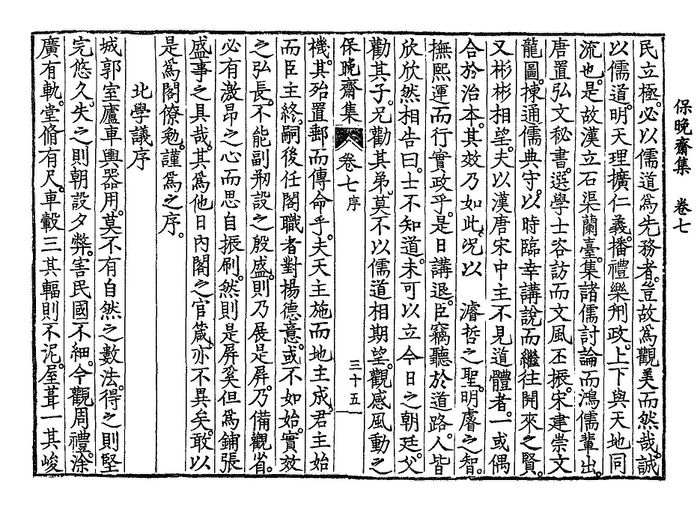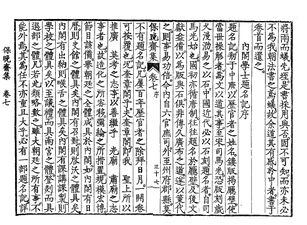(Translation) 徐命膺 北學議序
| Primary Source | ||
|---|---|---|
 |
Title | |
| English | Preface to The Commentary on Puk'ak | |
| Chinese | 北學議 序 | |
| Korean(RR) | 북학의 서(Bukagui Seo) | |
| Text Details | ||
| Genre | Literati Writings | |
| Type | ||
| Author(s) | 徐命膺 | |
| Year | ||
| Source | Korean Classics and Literati's Collection of Writings (한국고전종합DB) | |
| Key Concepts | ||
| Translation Info | ||
| Translator(s) | Participants of 2019 JSG Summer Hanmun Workshop (Advanced Translation Group) | |
| Editor(s) | ||
| Year | 2019 | |
목차
- 1 Introduction
- 2 Original Script
- 3 Discussion Questions
- 4 Further Readings
- 5 References
- 6 Translation
- 6.1 (sample) : Jaeyoon Song
- 6.2 Student 1 : Yishu Ma
- 6.3 Student 2 : Samuel Sai Hay Chan 陳世熙 진세희
- 6.4 Student 3 : Younès M'Ghari
- 6.5 Student 4 : King Kwong Wong
- 6.6 Student 5 : 신동조
- 6.7 Student 6 : Stacey Lui
- 6.8 Student 7 : Russell Guilbault
- 6.9 Student 8 : Q
- 6.10 Student 9 : (Write your name)
- 6.11 Student 10 : Yeonjae Ra
- 6.12 Student 11 : (Write your name)
Introduction
Original Script
| Classical Chinese | English |
|---|---|
|
城郭室廬車輿器用。莫不有自然之數法。得之則堅完悠久。失之則朝設夕弊。害民國不細。今觀周禮。涂廣有軌。堂脩有尺。車轂三其輻則不泥。屋葺一其峻則易溜。以至金石之劑量。韋革之緩急。絲之漚漆之髹。莫不謹書該載。此可見聖人之識廣大精微。包括萬有之數法。各造其極。何嘗以爲瑣屑而去之乎。 |
As to things like city walls, houses, carriages, and tools, all of them have a numerical standard endowed by nature. If you follow these standards [faithfully], things will be solid, complete, and enduring. If you do not, things that are built in the morning will fall apart in the evening, bringing much harm to the people and country. Now studying the Rites of Zhou, [we would notice that] the width of roads has its standards and the length of houses has its conventions. If a wheel’s hub is one third of the length of the spoke, the wheel does not get stuck in the mud. And if a roof’s slope is of one to one ratio to its height, the roof drains properly. As to things like the proportion of metals and stones [in metallurgy], the arrangement of soft and hard skin hides [in tanning], the soaking of silk and the painting with dye, all are recorded in the book. Here, one may see that the knowledge of the Sages, which includes numerical standards for ten thousand things, is vast, important, profound, and subtle; everything is made to its ideal [form]. How could one ever consider [them] trivial and slight [them]? |
|
自漢以後。儒者不能通萬有之數法。槩曰此百工之事也。凡當時制度之書。但載其大綱。然中州則業有顓門。技有師授。又四方才智之士因其性之所通。各致其精。互相傳襲。而其城郭室廬車輿器用。違聖人數法者盖寡。是以精緻牢固。無傷財害民之患。而我國則不能然。諸有山澤之利。一皆歸之於修毁補弊之費。及其不能繼。則曰我國貧國也。嗚呼。國果貧乎。數法失其宜乎。 |
From the Han dynasty onward, scholars [in our country] no longer mastered the universal numerical standards and said that these [numerical standards] were the affairs of artisans. [This was why] all the books about numerical conventions at that time only contained general descriptions. In China, however, there are experts in every occupation and masters for every craftsmanship. Learned and talented scholars from all corners of the country understand the nature [of learnings on numerical standards] and push their understanding to the utmost, passing down what they knew from generation to generation. When it comes to things like city walls, houses, carriages, and tools, few scholars deviate from the numerical standards set out by the Sages. Therefore, [what they build] are refined, delicate, solid and firm - free from the trouble of damaging wealth and harming the people. However, our country is not like this. Although our country benefits from [the nourishment of] the mountains and waters, all these benefits are wasted in the expense of repairments and maintenances, the amount of which becomes unbearable as time goes by. Therefore, our country is said to be an impoverished one. Alas! But is it that our country is poor in actuality? Or is it that the numerical standards have lost their proprieties? |
|
朴齊家次修。奇士也。歲戊戌。隨陳奏使入燕。縱觀其城郭室廬車輿器用。歎曰。此皇明之制度也。皇明之制度。又周禮之制度也。凡遇可以通行於我國者。熟視而竊識之。或有未解。復博訪以釋其疑。歸而筆之於書。爲北學議內外篇。其紀數詳密。布法明暢。且附以同志之論。一按卷可推行。噫。何其用心勤且摯也。次修。勉之哉。方今聖上欲編輯一部法書。以金聲玉振於國典。而考周公作周禮之例。先命六官庶司。各記其職之所有事者。以擬淘成一書。無乃是書爲伊時之所採用乎。夫天將風而鳶先嘯。將雨而蟻先垤。是書採用與否。固不可知。而亦未必不爲我朝法書之鳶蟻。故余道其有感於中者。書于卷首而還之。 |
Pak Cheka, with courtesy name of Ch'asu, is an extraordinary scholar. In the year of Musul [1778 in Gregorian calendar], he followed the Envoy for Presenting Circumstances to Beijing, where Pak saw the city walls, houses, carriages, and tools there and lamented, “this is the institution of the august Ming.” The institution of the august Ming is also that [recorded] in the Rites of Zhou. Whenever he came across [a structure or an object the numerical principle of which] can be utilized in our country, Pak studied it fastidiously and learned [the convention of which] in secret. If there was any incomprehension, he would go around and make visits [to scholars] to solve the mystery. On his way back [to Choson], he recorded his learnings with a pen in a book, which later became the Inner and Outer Chapters of the Commentary on Puk'ak. The volumes of this book are detailed and meticulous, and its organization limpid, not to mention its inclusion of several essays written by Pak’s peers of like minds. Once it is studied, the book contains [numerical conventions] that can be implemented immediately [throughout the country]. Alas, how dedicated, diligent, and ingenuous you are! Ch'asu, I exhort you! Recently, the King wished to compile a book of [numerical] conventions so as to refining the Grand Code [for State Administration]. When the Duke of Zhou authored the Rites of Zhou, he first ordered the Six Ministers and their offices to record everything relevant to their posts and planned to make a book out of them. Could this book be ratified [into the Grand Code for State Administration]? It is when the wind blows, the kite bird screeches; it is when the rain comes, the ant crawls [for the ant hills] (5). Whether this book would be ratified, there is no way to know. Perhaps it would not be the kite bird and ant for the Grand Code of our country. I am therefore writing down my feelings about the situation in this preface. (translation) |
Discussion Questions
Further Readings
References
Translation
(sample) : Jaeyoon Song
- Discussion Questions:
Student 1 : Yishu Ma
- Discussion Questions:
城郭室廬車輿器用。莫不有自然之數法。得之則堅完悠久。失之則朝設夕弊。害民國不細。今觀周禮。涂廣有軌。堂脩有尺。
Translation: As to things like city walls, cottages, carriages, and useful items, there is nothing that does not have the numerical standards. If you get the standards right, all these things will be solid, complete, and enduring. If you lost the standards, these things you set up in the morning will become your defective in the evening and do harm to our people and country greatly. Now observing the Rites of Zhou, the roads are wide but have their tracks (to follow); the halls are long but have chi (chok) (to measure them).
Student 2 : Samuel Sai Hay Chan 陳世熙 진세희
- Discussion Questions:
車轂三其輻則不泥。屋葺一其峻則易溜。以至金石之劑量。韋革之緩急。絲之漚漆之髹。莫不謹書該載。
The hub of a cart's wheel should be three inches long, so that its axis would not be stuck in the mud. The
Reference: 冬官考工記: 參分其轂長,二在外,一在內,以置其輻。
Student 3 : Younès M'Ghari
此可見聖人之識廣大精微。包括萬有之數法。各造其極。何嘗以爲瑣屑而去之乎。
It shows, here, that the knowledge of the Sages are vast and important, profound and subtle. They include numerical standards for ten thousand things1; everything is made to its ideal [form]. How could one ever consider [them] trivial and eliminate [them]?
1 萬有之, that is "a myriad of things", "all things".
- Discussion Questions:
How did the author of this text come to know about Pak Je? Are they exchanging letters?
Where were the copies of the Rites of Zhou preserved at? Who could access them? Or were they present in every scholar's personal bookshelves?
Student 4 : King Kwong Wong
- Discussion Questions:
- What was the background leading to the promotion of the Northern Learning in Chosŏn (Joseon)? Considering the hostility of the Chosŏn literati against the Qing, how did their view of the Qing change?
- How important are Chinese classics to the intellectual thought of the Chosŏn literati?
自漢以後。儒者不能通萬有之數法。槩曰此百工之事也。凡當時制度之書。但載其大綱。
From the Han dynasty onward, scholars could not understand the universal numerical standards. Generally speaking, these are the affairs of all artisans. All the books writing about the institutions at that time only contain their general outlines.
Student 5 : 신동조
- Discussion Questions:
然中州則業有顓門。技有師授。又四方才智之士因其性之所通。各致其精。互相傳襲。而其城郭室廬車輿器用。
In China, however, there are experts in every occupation. As to technologies, it has been transmitted from masters. Just relying upon their good nature, moreover, those talented and knowledgeable scholars from all directions understood, pushed it to utmost, and transmit (what they know) from generation to generation. Therefore, there are few city walls, houses, carriages, and all the other useful items that violate the numerical standards of the Sages.
Student 6 : Stacey Lui
- Discussion Questions:
Pak Chega is often referred to as a 'sirhak' scholar - a term sirhak coined after the time of Pak and his contemporaries. What does 'sirhak' describe?
What kind of scientific and technological advances were made in the time of Pak?
違聖人數法者盖寡。是以精緻牢固。無傷財害民之患。而我國則不能然。
There were few who disobeyed the numerical standard of the sages. Therefore, it [what they did] was refined, delicate, solid and firm - free of the trouble of damaging wealth or harming the people. However, our country cannot be like this.
Student 7 : Russell Guilbault
- Discussion Questions:
諸有山澤之利。一皆歸之於修毁補弊之費。及其不能繼。則曰我國貧國也。嗚呼。國果貧乎。數法失其宜乎。
All [countries] benefit from mountains and lakes [i.e., natural resources]. All are put into the cost of fixing damages and repairing shortcomings. When this cannot be continued, then our country is said to be a poor country. Alas! But is it that country has ended up poor? Or is it that the ways of measuring have lost their fittingness?
Student 8 : Q
- Discussion Questions:
朴齊家次修。奇士也。歲戊戌。隨陳奏使入燕。縱觀其城郭室廬車輿器用。歎曰。此皇明之制度也。皇明之制度。又周禮之制度也。
Pak Cheka (Bak Jega), with courtesy name Ch'asu (Chasu), is an extraordinary scholar. In 1778, he went to Beijing, following the envoy bearing the memorial to the emperor[1]. Pak continued observing their fortresses, warehouses, wagons and wares. Indeed, they were according to the institutions of the august Ming. The practices of Ming, in turn, are those of the rituals of Zhou.
Would it be possible to determine if what the author had in mind is closer to a more precisely determined order--arguably scientific--or an expansion of the ordered world as in imposition of order on things as a part of the process?
Student 9 : (Write your name)
- Discussion Questions:
凡遇可以通行於我國者。熟視而竊識之。或有未解。復博訪以釋其疑。歸而筆之於書。爲北學議內外篇。其紀數詳密。布法明暢。且附以同志之論。一按卷可推行。
Student 10 : Yeonjae Ra
- Discussion Questions:
噫。何其用心勤且摯也。次修。勉之哉。方今聖上欲編輯一部法書。以金聲玉振於國典。而考周公作周禮之例。先命六官庶司。各記其職之所有事者。以擬淘成一書。無乃是書爲伊時之所採用乎。
Ah! How could he be so sincere and earnest! 次修(朴齊家의 字), you really made an effort here. Most recently the king(正祖) wishes to compile one corpus of the book of models and make it as a collection of the canon. Therefore consider that the duke of Zhou made the case of the Rites of Zhou. The king first ordered six ministries and bureaucrats, and each offices write down what they do, then compare and revise, making it into a book. How can we not mention this writing becomes to be collected at that time?
Student 11 : (Write your name)
- Discussion Questions:
- ↑ "chinjusa" ("jinjusa")

